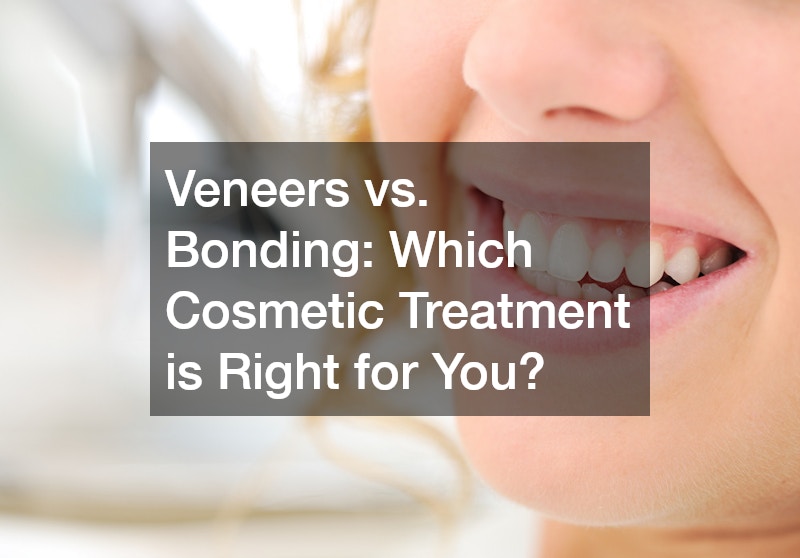Key Takeaways
-
Veneers provide long-lasting, highly aesthetic results suitable for comprehensive smile makeovers.
-
Dental bonding is quick, affordable, and minimally invasive, ideal for minor imperfections.
-
Veneers require enamel removal, making them a permanent solution.
-
Bonding is less durable and may need replacement more frequently.
-
A dental practice for cosmetic treatments can guide you through the decision process.
-
Maintenance and proper oral hygiene are critical for both treatments.
-
Budget, desired outcome, and lifestyle should influence your choice between veneers and bonding.

A confident, radiant smile can make a significant difference in both personal and professional life. Beyond aesthetics, a healthy-looking smile can improve self-esteem, enhance first impressions, and boost overall confidence. Many patients turn to a dental practice for cosmetic treatments to address imperfections such as chips, discoloration, gaps, or irregularly shaped teeth. Among the most popular options are veneers and dental bonding. Both procedures are designed to enhance the appearance of your teeth, yet they differ in terms of procedure, cost, longevity, and the level of transformation they provide. Understanding these differences can help you make an informed decision about which treatment is right for your smile.
What Are Veneers?
Veneers are ultra-thin shells, commonly made of porcelain or composite resin, that cover the front surface of teeth. They are custom-designed to improve the shape, color, length, and overall appearance of teeth, creating a uniform and attractive smile.
A professional cosmetic dentist may recommend veneers for patients who have:
-
Teeth that are severely discolored or stained and cannot be improved with traditional whitening treatments
-
Chips, cracks, or surface wear from grinding or injury
-
Minor misalignments or irregularly shaped teeth
-
Gaps that impact the overall appearance of the smile
Advantages of Veneers
Veneers are highly durable and can last 10–15 years or more with proper care. Porcelain veneers are particularly resistant to staining, making them ideal for patients who consume coffee, tea, or red wine regularly. Veneers also allow for comprehensive smile improvement by addressing multiple cosmetic concerns simultaneously. Since each veneer is customized, it can perfectly match the color, size, and shape of surrounding teeth, resulting in a natural-looking smile.
Veneer Procedure Overview
-
Consultation and Assessment: The dentist evaluates oral health, bite alignment, and aesthetic goals.
-
Preparation: Minimal enamel is removed to allow veneers to fit properly.
-
Impressions: Accurate impressions of your teeth are taken to create custom veneers.
-
Temporary Veneers: While the permanent veneers are fabricated, temporary veneers may be placed.
-
Final Placement: Veneers are bonded to the teeth using strong dental adhesive and polished for a smooth finish.
Patients often report a dramatic improvement in confidence and satisfaction after receiving veneers, making them an excellent choice for those seeking a long-term, transformative solution.
What Is Dental Bonding?

Dental bonding is a cosmetic procedure in which a tooth-colored composite resin is applied directly to the surface of a tooth. The resin is sculpted to improve the tooth’s appearance and then hardened with a special curing light. Bonding is a quick and minimally invasive option for correcting minor imperfections, making it an attractive alternative for patients seeking a faster and more affordable solution.
A reputable dental practice for cosmetic treatments may suggest bonding for individuals who want to:
-
Repair small chips or cracks
-
Close minor gaps between teeth
-
Cover surface discoloration or stains
-
Slightly reshape uneven or misshapen teeth
Advantages of Dental Bonding
Bonding is typically completed in a single dental visit, making it convenient for patients with busy schedules. It is also less expensive than veneers, offering a cost-effective way to improve a smile without major procedures. Because little to no enamel is removed during bonding, the procedure is minimally invasive and reversible if adjustments are needed.
Bonding Procedure Overview
-
Preparation: The tooth is cleaned and prepared, and a conditioning agent is applied to improve adhesion.
-
Application: Composite resin is applied to the tooth surface and sculpted to achieve the desired shape.
-
Curing: The resin is hardened using a special light.
-
Finishing: The treated tooth is polished to match the natural texture and sheen of surrounding teeth.
Bonding is particularly well-suited for patients looking for subtle improvements or quick corrections to a single tooth or a few teeth rather than a full smile makeover.
Comparing Veneers and Bonding
When deciding between veneers and bonding, it’s important to weigh the benefits and limitations of each procedure.
Veneers Pros:
-
Provide a highly aesthetic and polished appearance
-
Correct multiple cosmetic issues at once
-
Resistant to stains and discoloration
-
Long-lasting and durable
Veneers Cons:
-
Higher cost due to custom fabrication and materials
-
Enamel removal is permanent, making the procedure irreversible
-
Requires multiple visits for preparation and placement
-
Repair or replacement can be more complex
Bonding Pros:
-
Quick, often completed in a single visit
-
Affordable and cost-effective
-
Minimally invasive, preserving natural tooth structure
-
Reversible and adjustable
Bonding Cons:
-
Less durable than veneers and prone to chipping or staining
-
Shorter lifespan, often requiring touch-ups or replacement within a few years
-
Limited ability to correct significant cosmetic issues
Factors to Consider When Choosing Between Veneers and Bonding
A professional dental practice for cosmetic treatments can help patients evaluate several factors when choosing the best treatment:
Desired Outcome
-
Veneers are ideal for patients seeking a comprehensive smile transformation or correction of multiple imperfections.
-
Bonding is suitable for minor corrections or aesthetic enhancements to individual teeth.
Budget
-
Veneers typically cost between $800 and $2,500 per tooth, depending on material and complexity.
-
Bonding is more affordable, generally ranging from $100 to $600 per tooth.
Longevity
-
Veneers can last 10–15 years or longer with proper care.
-
Bonding usually lasts 3–10 years depending on oral hygiene, habits, and maintenance.
Dental Health
-
Veneers require healthy teeth with sufficient enamel for proper adhesion.
-
Bonding is less invasive, making it a suitable option for patients who want to preserve more of their natural tooth structure.
Lifestyle Considerations
-
Veneers offer a low-maintenance, long-lasting solution suitable for individuals with an active lifestyle.
-
Bonding may be affected by habits such as teeth grinding, nail-biting, or frequent consumption of staining foods and drinks.
How a Dental Practice for Cosmetic Treatments Can Assist
Choosing the right cosmetic dental treatment can feel overwhelming. A reputable dental practice for cosmetic treatments provides guidance and ensures patients understand all aspects of the procedures. Services typically include:
-
Comprehensive Smile Assessment: The dentist evaluates oral health, tooth alignment, bite, and cosmetic goals.
-
Digital Smile Preview: Advanced imaging can simulate post-treatment results for both veneers and bonding.
-
Personalized Treatment Planning: Patients receive detailed explanations of procedure options, pros and cons, timelines, and cost considerations.
-
Maintenance and Follow-Up Guidance: Recommendations on daily care, professional cleanings, and inspections to maintain results over time.
This individualized approach ensures patients make informed decisions and achieve results that meet both their aesthetic goals and practical needs.
Maintenance and Care
Maintaining the results of veneers and dental bonding is essential to ensure a long-lasting and attractive smile.
Veneers Maintenance Tips:
-
Brush with a soft-bristled toothbrush twice daily using non-abrasive toothpaste
-
Floss carefully to prevent gum irritation
-
Avoid biting hard objects such as ice, pens, or hard candies
-
Attend regular dental checkups for professional cleaning and inspection
Bonding Maintenance Tips:
-
Limit foods and beverages that can stain, such as coffee, tea, or red wine
-
Avoid habits that could chip the resin, like biting fingernails or chewing on hard objects
-
Maintain excellent oral hygiene through regular brushing and flossing
-
Visit the dentist periodically to polish and check bonded teeth for wear
Common Questions About Veneers and Bonding
Are veneers painful?
Veneers are generally painless. Local anesthesia is used during enamel preparation, and any sensitivity afterward is typically temporary.
Can bonding stain like natural teeth?
Yes, bonding material can absorb stains over time. Minimizing exposure to coffee, tea, or tobacco can help maintain its appearance.
How do I choose the right cosmetic dentist?
Select a dental practice for cosmetic treatments with experienced cosmetic dentists, strong patient reviews, and before-and-after galleries showcasing successful results.
Can veneers be replaced?
Yes, veneers can be replaced if they become damaged or worn. Replacement requires careful removal and fabrication of new custom shells to ensure a natural appearance.
Cost Comparison
| Treatment | Average Cost per Tooth | Longevity | Time Required |
|---|---|---|---|
| Veneers | $800 – $2,500 | 10–15+ years | 2–3 visits |
| Bonding | $100 – $600 | 3–10 years | 1 visit |
While veneers provide a long-term, high-quality aesthetic solution, bonding is an excellent short-term option for minor corrections or touch-ups.
Conclusion: Which Cosmetic Treatment Is Right for You?
Ultimately, the choice between veneers and dental bonding depends on your individual goals, budget, and lifestyle. Veneers are ideal for patients seeking a dramatic, long-lasting transformation, whereas bonding is best suited for quick, affordable corrections of minor imperfections. Consulting a trusted dental practice for cosmetic treatments ensures you receive professional guidance, personalized treatment planning, and results that provide both a healthy and beautiful smile. By understanding your options and carefully considering your goals, you can achieve a smile that boosts confidence and leaves a lasting impression.


